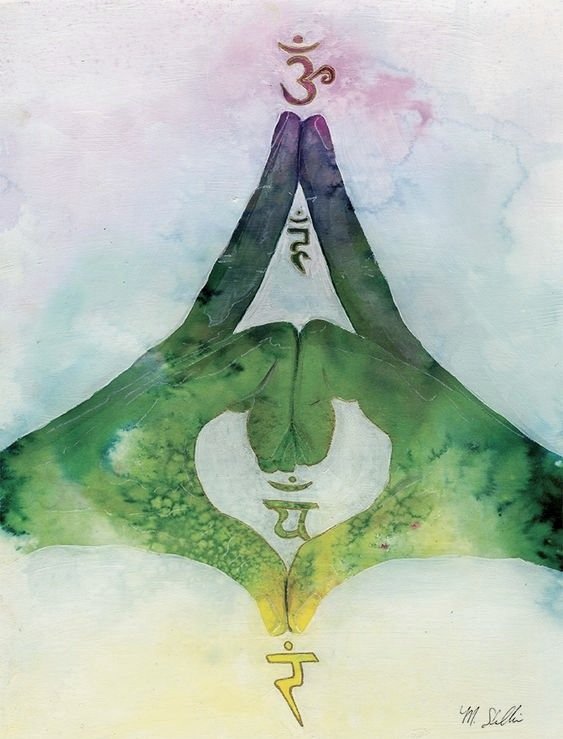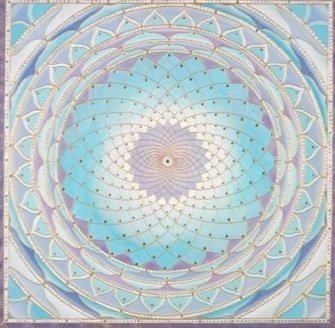Chakra System and Kundalini Energy: A Tantric Path to Self-Realization
The chakra system is a profound map of our energetic anatomy, guiding us on a transformative journey of self-realization and spiritual awakening
Tantra encompasses a diverse range of practices and principles, including the exploration of chakras and the awakening of Kundalini energy. In this blog, we will delve deeper into the intricate web of Tantra, understanding the significance of the chakra system and exploring the specific Tantric practices associated with each chakra. We will also explore how various mystical systems, such as Sufism, the Kabbalah Tree of Life, and Egyptian mysticism, feature energetic centers similar to the chakra system.
The Chakra System and Kundalini Energy:
In the Tantric tradition, the chakra system is a fundamental aspect of spiritual exploration and self-realization. The word "chakra" originates from the ancient Sanskrit language and translates to "wheel" or "disk." It refers to the swirling vortexes of energy that exist within our subtle energetic body. These chakras are often described as spinning wheels of light, each associated with specific qualities and functions.
The chakra system is intimately connected to the awakening of Kundalini energy. Kundalini, which translates to "coiled serpent," represents the dormant spiritual energy that lies at the base of the spine. It is depicted as a coiled serpent because, like a serpent, it has the potential to rise and expand.
When the chakras are activated and balanced, they create a clear pathway for the Kundalini energy to ascend through the central energy channel, known as the Sushumna. As the Kundalini energy rises, it pierces through each chakra, awakening and transforming our consciousness. This process leads to spiritual awakening, self-realization, and the ultimate union with the divine.
Each chakra in the system corresponds to specific physical, emotional, mental, and spiritual aspects of our being. There are traditionally seven major chakras, starting from the base of the spine and extending to the crown of the head.
Awakening Kundalini energy is like unlocking the dormant potential within us, allowing us to tap into higher states of consciousness and experience profound spiritual transformation.
The Root Chakra - Muladhara:
The Root Chakra is located at the base of the spine and is associated with our sense of grounding, stability, and physicality. It is symbolized by the color red and is connected to the element of Earth. To activate and balance the Root Chakra, you can practice grounding yoga postures such as Tadasana (Mountain Pose) and Virabhadrasana (Warrior Pose). Engaging in deep, rhythmic breathing techniques like Dirga Pranayama (Three-Part Breath) can also be beneficial for grounding and connecting with the Root Chakra.
Practice: Begin by finding a comfortable seated position. Take a few deep breaths to center yourself. As you inhale, visualize the breath traveling down to the base of your spine, filling the area with energy and vitality. As you exhale, imagine any tension or stagnant energy being released from the Root Chakra. Continue this breathing pattern for several minutes, allowing yourself to feel deeply rooted and connected to the Earth.
The Sacral Chakra - Svadhisthana:
Moving up the energy body, we encounter the Sacral Chakra, located in the lower abdomen. This chakra is associated with our creativity, sensuality, and emotional well-being. It is represented by the color orange and is connected to the element of Water. To activate and balance the Sacral Chakra, you can practice hip-opening yoga postures such as Baddha Konasana (Bound Angle Pose) and Ananda Balasana (Happy Baby Pose). Incorporating the breathwork technique of Sama Vritti (Equal Breathing) can also help enhance the flow of energy in this chakra.
Practice: Find a comfortable seated position and bring your attention to the area just below your navel. As you inhale, imagine the breath flowing into the Sacral Chakra, filling it with vibrant orange light. As you exhale, visualize any tension or blockages being released from this area. Continue this breathwork, focusing on the smooth, equal duration of inhalation and exhalation, for several minutes, allowing the energy to flow freely through the Sacral Chakra.
The Solar Plexus Chakra - Manipura:
The Solar Plexus Chakra is located in the area above the navel and is associated with our personal power, confidence, and self-esteem. It is symbolized by the color yellow and is connected to the element of Fire. Yoga postures that engage the core muscles, such as Navasana (Boat Pose) and Ardha Navasana (Half Boat Pose), can be practiced to activate and balance the Solar Plexus Chakra. Incorporating the breathwork technique of Kapalabhati (Skull Shining Breath) can help ignite the fire within and stimulate this chakra's energy.
Practice: Sit in a comfortable position with a tall spine. Take a few deep breaths to center yourself. Begin Kapalabhati by taking a quick, forceful exhale through the nose, followed by a passive inhale. Repeat this rapid exhalation-inhalation cycle, focusing on the forceful exhalation to stimulate the Solar Plexus Chakra. Continue for about 1-2 minutes, gradually building up to longer durations as you become more comfortable with the practice.
Art by Monica Stadalski
As we activate and balance each chakra, we create a harmonious flow of energy within ourselves, leading to a deeper sense of connection, wholeness, and self-discovery
The Heart Chakra - Anahata:
The Heart Chakra, located in the center of the chest, is associated with love, compassion, and emotional healing. It is represented by the color green and is connected to the element of Air. Heart-opening yoga postures such as Ustrasana (Camel Pose) and Bhujangasana (Cobra Pose) can be practiced to activate and balance the Heart Chakra. The breathwork technique of Anulom Vilom (Alternate Nostril Breathing) can also be incorporated to harmonize the flow of energy in this chakra.
Practice: Find a comfortable seated position and bring your attention to the heart center. Close your right nostril with your right thumb and inhale deeply through the left nostril. Close the left nostril with your right ring finger and release the right nostril, exhaling fully. Inhale through the right nostril, close it, and exhale through the left. Repeat this alternate nostril breathing pattern for several minutes, focusing on the gentle, balanced flow of breath in and out of the heart center.
The Throat Chakra - Vishuddha:
Moving up to the throat area, we encounter the Throat Chakra, which is associated with communication, self-expression, and authentic voice. It is symbolized by the color blue and is connected to the element of Sound. Practicing yoga postures that stretch and open the neck and throat region, such as Matsyasana (Fish Pose) and Salamba Sarvangasana (Supported Shoulderstand), can help activate and balance the Throat Chakra. Incorporating the breathwork technique of Ujjayi Pranayama (Victorious Breath) can further support the flow of energy in this chakra.
Practice: Sit in a comfortable position with a tall spine. Take a few deep breaths to center yourself. As you inhale and exhale through the nose, slightly constrict the back of your throat to create a soft, gentle sound resembling ocean waves. Focus on the sound and sensation of the breath as it flows in and out, directing your awareness to the throat area. Continue this Ujjayi Pranayama for several minutes, allowing the breath to become smooth, deep, and soothing.
The Third Eye Chakra - Ajna:
The Third Eye Chakra is located between the eyebrows and is associated with intuition, insight, and spiritual awareness. It is represented by the color indigo and is connected to the element of Light. Yoga postures that bring focus and attention to the forehead area, such as Balasana (Child's Pose) and Janu Sirsasana (Head-to-Knee Forward Bend), can be practiced to activate and balance the Third Eye Chakra. Incorporating the breathwork technique of Brahmari Pranayama (Bee Breath) can help awaken and refine the inner vision associated with this chakra.
Practice: Find a comfortable seated position and close your eyes. Place your index fingers on your temples, gently pressing the area. Take a deep breath in, and as you exhale, make a humming sound like a bee, focusing the vibration and sound on the forehead area. Repeat this Brahmari Pranayama for several rounds, allowing the vibrations to stimulate and activate the Third Eye Chakra.
The Crown Chakra - Sahasrara:
At the top of the head, we find the Crown Chakra, which is associated with spiritual connection, universal consciousness, and transcendence. It is symbolized by the color violet or white and is connected to the element of Thought. While there are no specific yoga postures directly targeting the Crown Chakra, incorporating meditation practices that focus on the crown area, such as Sahasrara Dharana (Crown Chakra Meditation) or practicing the yoga posture of Shavasana (Corpse Pose) with awareness and intention, can help open and balance this chakra. Breathwork techniques like Nadi Shodhana (Alternate Nostril Breathing) can also support the flow of energy in the Crown Chakra.
Practice: Find a comfortable seated position or lie down in Shavasana. Close your eyes and bring your awareness to the top of your head. Visualize a radiant white or violet light emanating from the crown area, expanding and enveloping your entire being. As you breathe deeply, imagine this light permeating every cell of your body, connecting you to the infinite universal consciousness. Stay in this state of deep connection and awareness for several minutes, allowing the energy to flow freely through the Crown Chakra.
Art by Paul Heussenstamm
Chakra-like Systems in Mystical Traditions
It is fascinating to note that the concept of energetic centers similar to the chakra system can be found in various mystical and spiritual traditions across the world. For example, in Sufism, the mystical branch of Islam, there is a belief in the existence of seven subtle centers of energy called "lataif.In the Gnostic tradition, the concept of energetic centers is associated with the development of the "Pleroma," a term that represents the divine realm. The Kabbalah, a mystical branch of Judaism, features the Tree of Life, which is a symbolic representation of the chakra-like energy centers called "sefirot."In ancient Egyptian mysticism, there is a belief in the existence of energetic centers called "djed pillars" or "sacred spines." These pillars correspond to the chakra-like energy centers and are associated with the awakening and ascension of the soul.
These similarities across different mystical traditions highlight the universality of the chakra system and its significance in the journey of self-realization. They emphasize the importance of understanding and working with the subtle energetic centers within us to achieve spiritual growth and union with the divine.
Exploring the chakra system is an invitation to embark on a sacred journey of self-exploration, where we unlock the wisdom and power that resides within each energetic center.
To learn more about the mechanics of the O-Method and how to effectively utilize pleasure for manifestation, we invite you to explore our O-Method Ritual where we dive into the principles and techniques of the O-Method.




